Supergene Copper and the Ancient Mining Landscapes of the Atacama Desert: Refining the Protocol for the Study of Archaeological Copper Minerals through the Case Study of Pukara de Turi
Abstract
1. Introduction
2. Geochemical Characterisation of Pre-Hispanic Copper Ores in the Atacama Desert
3. Selection and Description of Samples
4. Analytical Methodology
4.1. Micro-X-ray Fluorescence (µ-XRF)
4.1.1. Mineral Classification Using µ-XRF Data
4.1.2. Elemental Maps and Point Analyses Using µ-XRF
4.2. X-ray Diffraction (XRD)
4.3. Raman Spectroscopy
4.4. Automated Mineralogy (QEMSCAN)
4.5. Technological Study
5. Results
5.1. Mineralogy of Samples with Micro-X-ray Fluorescence, X-ray Diffraction and Raman Spectroscopy
5.2. Mineralogical Maps with Automated Mineralogy (QEMSCAN)
5.3. Technological Study of the Copper Minerals
6. Discussion
6.1. Atacamite/Brochantite Association
6.2. Azurite/Chrysocolla Association
6.3. The Known Pre-Hispanic Ores of Atacama La Baja
6.4. Copper Mineral Technologies and the Production Context
7. Conclusions
Author Contributions
Funding
Data Availability Statement
Acknowledgments
Conflicts of Interest
References
- Camus, F.; Dilles, J.H. A Special Issue Devoted to Porphyry Copper Deposits of Northern Chile. Econ. Geol. 2001, 96, 233–237. [Google Scholar] [CrossRef]
- Figueroa, V.; Salazar, D.; Salinas, H.; Núñez-Regueiro, P.; Manríquez, G. Pre-hispanic mining ergology of northern chile: An archaeological perspective. Chungara 2013, 45, 61–81. [Google Scholar] [CrossRef][Green Version]
- Vaughn, K.J.; Tripcevich, N. An introduction to mining and quarrying in the ancient Andes: Sociopolitical, economic and symbolic dimensions. In Mining and Quarrying in the Ancient Andes: Sociopolitical, Economic and Symbolic Dimensions; Tripcevich, N., Vaughn, K., Eds.; Springer: New York, NY, USA, 2013; pp. 3–19. [Google Scholar] [CrossRef]
- Zori, C. Extracting Insights from Prehistoric Andean Metallurgy: Political Organization, Interregional Connections, and Ritual Meanings. J. Archaeol Res. 2019, 27, 501–556. [Google Scholar] [CrossRef]
- Berenguer, J.; Salazar, D. Territorialización del modelo minero inkaico en el río Salado: Una aglomeración productiva entre Lípez y San Pedro de Atacama. Bol del Mus Chil Arte Precolomb 2017, 22, 51–69. [Google Scholar] [CrossRef]
- Figueroa, V.; Mille, B.; Salazar, D.; Berenguer, J.; Menzies, A.; Sapiains, P.; Cifuentes, A.; Joly, D. A major Prehispanic copper production center identified at Collahuasi, Southern Tarapacá Altiplano (Chile). Chungara 2018, 50, 557–575. [Google Scholar] [CrossRef]
- Núñez, L. Valoración minero-metalúrgica circumpuneña: Menas y mineros para el Inka Rey. Estud Atacameños 1999, 18, 177–222. [Google Scholar] [CrossRef]
- Núñez, L.; Grosjean, M.; Cartajena, I. The expansion of the Inka empire into the Atacama Desert. In 23°S Archaeology and Environmental History of the Southern Deserts; Smith, M., Hesse, P., Eds.; National Museum of Australia Press: Canberra, Australia, 2005; pp. 324–332. [Google Scholar]
- Salazar, D. La producción minera en San José del Abra durante el Período Tardío Atacameño. Estud Atacameños 2008, 36, 43–72. [Google Scholar] [CrossRef]
- Melero, D.; Salazar, D. Historia colonial de Conchi Viejo y San José del Abra, y su relación con la minería en Atacama, Norte de Chile. Rev. Hist. Indígena 2003, 7, 55–86. [Google Scholar]
- González, L.R. El Arte Del Cobre En Los Andes Prehispánicos: Historias de Poder, Brillos y Colores. In El Arte del Cobre en el Mundo Andino; Berenguer, J., Ed.; Museo Chileno de Arte Precolombino: Santiago, Chile, 2003; pp. 8–59. [Google Scholar]
- Lechtman, H. Andean Metallurgy in Prehistory. In Archaeometallurgy in Global Perspective: Methods and Syntheses; Roberts, B., Thornton, C., Eds.; Springer: New York, NY, USA, 2014; pp. 361–422. [Google Scholar] [CrossRef]
- Cifuentes, A.; Figueroa, V.; Salazar, D.; Mille, B. Producción metalúrgica local y coexistencia de tecnologías metalúrgicas en San Pedro de Atacama durante el Período Medio (400–1000 DC). Chungará 2018, 50, 423–439. [Google Scholar] [CrossRef]
- Salazar, D. El complejo Minero San José del Abra, II Región (1450–1536 d.C.). Una Aproximación a la Arqueología de la Minería. Tesis Para Optar al Grado de Magíster en Arqueología, Universidad de Chile, Santiago, Chile, 2002. [Google Scholar]
- Angiorama, C.I. Producción y circulación de objetos de metal en la Quebrada de Humahuaca en momentos prehispánicos tardíos. Unpublished. Ph.D. Thesis, Universidad Nacional de Tucumán, San Miguel de Tucumán, Argentina, 2003. [Google Scholar]
- Berenguer, J. Caravanas, Interacción y Cambio En El Desierto de Atacama; Sirawi Ediciones: Santiago, Chile, 2004; p. 604. [Google Scholar] [CrossRef][Green Version]
- Nielsen, A. Armas significantes: Tramas culturales, guerra y cambio social en el Sur Andino prehispánico. Boletín del Mus Chil Arte Precolomb 2007, 12, 9–41. [Google Scholar]
- Pimentel, G. Redes viales prehispánicas en el Desierto de Atacama. Viajeros, Movilidad e Intercambio. Unpublished. Ph.D. Thesis, Universidad Católica del Norte and Universidad de Tarapacá, San Pedro de Atacama, Chile, 2012. [Google Scholar]
- Rees, C. Elaboración, distribución y consumo de cuentas de malaquita y crisocola durante el Período Formativo en la Vega de Turi y sus inmediaciones, subregión del río Salado, norte de Chile. In Los Tres Reinos: Prácticas de Recolección En El Cono Sur de América; Aschero, C., Korstanje, A., Vuoto, P., Eds.; Instituto de Arqueología y Museo, Universidad Nacional de Tucumán: Tucumán, Argentina, 1999; pp. 85–98. [Google Scholar]
- Sepúlveda, M.; Figueroa, V.; Cárcamo, J. Pigmentos y pinturas de mineral de cobre en la región de Tarapacá, norte de Chile: Nuevos datos para una tecnología pigmentaria prehispánica. Estud Atacameños 2014, 1, 23–37. [Google Scholar] [CrossRef][Green Version]
- Sinclaire, C. Los sitios de “Muros y Cajas” del río Loa y su relación con el tráfico de caravanas. In Taller de Costa a Selva; Albeck, M.E., Ed.; Instituto Interdisciplinario Tilcara, Universidad de Buenos Aires: Buenos Aires, Argentina, 1994; pp. 51–76. [Google Scholar]
- Soto, C. Tipología de cuentas de collar en la Quebrada de Tulan (Salar de Atacama): Nueva línea de evidencia para la transición arcaico-formativo. In Proceedings of the Actas Del XVII Congreso Nacional de Arqueología Chilena, Valdivia, Chile, 9 October 2006; Ediciones Kultrún: Valdivia, Chile, 2010; Volume 2, pp. 1123–1134. [Google Scholar]
- Ulriksen, C.E. Mapa Metalogénico de Chile Entre Los 18° y 34°S, Escala 1:1.000.000; Servicio Nacional de Geología y Minería: Santiago, Chile, 1990; Volume 42, p. 112. [Google Scholar]
- Boric, R.; Díaz, F.; Maksaev, V. Geología y Yacimientos Metalíferos de La Región de Antofagasta; Servicio Nacional de Geología y Minería: Santiago, Chile, 1990; Volume 40, p. 246. [Google Scholar]
- Sillitoe, R.H.; Mckee, E.H. Age of Supergene oxidation and enrichment in the chilean porphyry copper province. Econ. Geol. 1996, 91, 164–179. [Google Scholar] [CrossRef]
- Brimhall, G.H.; Levi, B.; Nyström, J.O.; Enrique, T.F. Atacamite inclusions in rock-forming feldspars and copper-bearing smectites from the Radomiro Tomic mine, Chile: Copper-insoluble mineral occurrences. Econ. Geol. 2001, 96, 401–420. [Google Scholar] [CrossRef]
- Campos, E.; Menzies, A.; Sola, S.; Hernández, V.; Riquelme, R.; Barraza, M. Mineral resources in a sustainable world, Session 10, Concentration processes in sub-surface environments, Understanding Exotic-Cu Mineralisation: Part I—Characterization of Chrysocolla. In Proceedings of the 13th SGA Biennal Meeting, Nancy, France, 24–27 August 2015; André-Mayer, A.S., Cathelineau, M., Muchez, P., Pirard, E., Sindern, S., Eds.; Volume 3, p. 1153. [Google Scholar]
- Sapiains, P.; Menzies, A.; Figueroa, V.; Wilke, H.G.; Mille, B.; Salazar, D.; Berenguer, J. Estudio arqueomineralógico de las menas de cobre prehispánicas en Collahuasi, norte de Chile. Estud Atacameños 2020, 66, 83–103. [Google Scholar] [CrossRef]
- Kahou, Z.S.; Brichau, S.; Poujol, M.; Duchêne, S.; Campos, E.; Leisen, M.; d’Abzac, F.X.; Riquelme, R.; Carretier, S. First U-Pb LA-ICP-MS in situ dating of supergene copper mineralization: Case study in the Chuquicamata mining district, Atacama Desert, Chile. Miner. Depos. 2021, 56, 239–252. [Google Scholar] [CrossRef]
- Sillitoe, R.H. Epochs of intrusion-related copper mineralization in the Andes. J. S. Am. Earth Sci. 1988, 1, 89–108. [Google Scholar] [CrossRef]
- Salazar, D. Investigaciones arqueológicas sobre la minería incaica en San José del Abra (II región, norte de chile). Xama 2002, 15, 101–117. [Google Scholar]
- Salazar, D.; Salinas, H. Tradición y transformaciones en la organización de los sistemas de producción mineros en el norte de Chile prehispánico: San José del Abra, siglos I al XVI DC. In Mina y Metalurgia En Los Andes Del Sur Desde La Época Prehispánica Hasta El Siglo XVII; Cruz, P., Vacher, J.J., Eds.; Instituto Francés de Estudios Andinos: Sucre, Bolivia, 2008; pp. 163–200. [Google Scholar]
- Salazar, D.; Salinas, H.; McRostie, V.; Labarca, R.; Vega, G. Cerro Turquesa: Diez siglos de producción minera en el extremo norte de Chile. In Proceedings of the Actas Del XVII Congreso Nacional de Arqueología Chilena, Valdivia, Chile, 9 October 2006; Ediciones Kultrún: Valdivia, Chile, 2010; Volume 2, pp. 1085–1097. [Google Scholar]
- Salazar, D.; Borie, C.; Oñate, C. Mining, Commensal Politics, and Ritual under Inca Rule in Atacama, Northern Chile. In Mining and Quarrying in the Ancient Andes: Sociopolitical, Economic, and Symbolic Dimensions; Tripcevich, N., Vaughn, K., Eds.; Springer: New York, NY, USA, 2013; pp. 253–274. [Google Scholar] [CrossRef]
- Aldunate, C.; Castro, V.; Varela, V. San Bartolo. Retazos de una historia de la minería en Atacama. In Proceedings of the Actas Del XVI Congreso Nacional de Arqueología Chilena, Concepción, Chile, 13–17 October 2003; Ediciones Escaparate: Concepción, Chile, 2005; pp. 213–224. [Google Scholar]
- Aldunate, C.; Castro, V.; Varela, V. San Bartolo y Cobija: Testimonios de un modo de vida minero en las tierras altas y la costa de Atacama. Estud Atacameños 2008, 35, 97–118. [Google Scholar] [CrossRef][Green Version]
- Westfall, C.; González, C. Mina Las Turquesas: Un asentamiento minero lapidario preincaico en el extremo meridional circumpuneño, Región de Atacama, Chile. In Proceedings of the Actas Del XVII Congreso Nacional de Arqueología Chilena; Valdivia, Chile, 9 October 2006, Ediciones Kultrún: Valdivia, Chile, 2010; Volume 2, pp. 1073–1084. [Google Scholar]
- Cantarutti, G.E. Mining Under Inca Rule in North-Central Chile: The Los Infieles Mining Complex. In Mining and Quarrying in the Ancient Andes; Springer: New York, NY, USA, 2013; pp. 185–211. [Google Scholar] [CrossRef]
- Bourgarit, D.; Mille, B. Provenance du cuivre et al.liages. In Circulation et Provenance Des. Matériaux Dans Les Sociétés Anciennes; Dillmann, P., Bellot-Gurlet, L., Eds.; Éditions des Archives Contemporaines: Paris, France, 2014; pp. 103–132. [Google Scholar] [CrossRef]
- Chavez, W. Supergene oxidation of copper deposits: Zoning and distribution of copper oxide minerals. Soc. Econ. Geol. Newsl. 2000, 41, 1–21. [Google Scholar] [CrossRef]
- Thibodeau, A.M. Isotopic Evidence For The Provenance of Turquoise, Mineral Paints, And Metals in the Southwestern United States. Ph.D. Thesis, University of Arizona, Tucson, AZ, USA, 2012. [Google Scholar]
- Kim, J.; Simon, A.W.; Ripoche, V.; Mayer, J.W.; Wilkens, B. Proton-induced x-ray emission analysis of turquoise artefacts from Salado platform Mound sites in the Tonto Basin of central Arizona. Meas Sci Technol. 2003, 14, 1579–1589. [Google Scholar] [CrossRef]
- González, C.; Westfall, C.; Castells, C. Mina las turquesas: Lapidaria, secuencia alfarera prehispánica e interrelaciones culturales en un espacio internodal del Desierto de Atacama, Chile. Estud Atacameños 2017, 56, 225–251. [Google Scholar] [CrossRef]
- Van Hoesen, J.; Arriaza, B.; Ryan, P.; Grady, C. A multianalytical approach for identifying a manganese source for the black pigment of the Chinchorro mortuary palette. Geoarchaeology 2019, 34, 322–335. [Google Scholar] [CrossRef]
- Carrión, H. Producción e identidad: Cuentas de Mineral de Cobre durante el Periodo Medio en San Pedro de Atacama. Tesis para optar al Título de Arqueólogo, Universidad de Chile, Santiago, Chile, 2015. [Google Scholar]
- Figueroa, V.; Salazar, D.; Mille, B.; Manríquez, G. Metal Use and Production among Coastal Societies of the Atacama Desert. Archaeometry 2015, 57, 687–703. [Google Scholar] [CrossRef]
- Coquinot, Y.; (Centre de Recherche et de Restauration des Musées de France, Paris, France). Field Observations and Results of Sample Analysis of Two Secondary Copper Mineral Deposits from: 1) the El Abra Turquoise-Rich Deposit and 2) Cerro Verde, Caspana “Chrysocolla-Azurite-Malachite-Cryptomelane”, Deposit. Report on File. Proyecto Arqueológico El Abra, 2013. Unpublished work.
- Sepúlveda, M.; Figueroa, V.; Pagés-Camagna, S. Copper Pigment-Making in the Atacama Desert (Northern Chile). Lat. Am. Antiq. 2013, 24, 467–482. [Google Scholar]
- Sepúlveda, M.; Valenzuela, D.; Cornejo, L.; Lienqueo, H.; Rousselière, H. Óxidos de manganeso en el extremo norte de Chile: Abastecimiento, producción y movilidad del color negro durante el Período Arcaico. Chungará 2013, 45, 143–159. [Google Scholar] [CrossRef]
- Aldunate, C. El pukara de Turi: Un testimonio monumental de continuidad cultural en la subárea Circumpuneña (s. XI al XVII). In Actas Del XII Congreso Nacional de Arqueología Chilena; Museo Regional de la Araucanía: Temuco, Chile, 1991; Volume 2, pp. 61–78. [Google Scholar]
- Scheller, S.; Tagle, R.; Gloy, G.; Barraza, M.; Menzies, A. Advancements in Minerals Identification and Characterization in Geo-Metallurgy: Comparing E-Beam and Micro-X-ray-Fluorescence Technologies. Microsc Microanal. 2017, 23, 2168–2169. [Google Scholar] [CrossRef][Green Version]
- Garrison, E. X-Ray diffraction (XRD): Applications in Archaeology. In Encyclopedia of Global Archaeology; Smith, C., Ed.; Springer: New York, NY, USA, 2014; pp. 7929–7933. [Google Scholar]
- Inizan, M.-L.; Reduron-Ballinger, M.; Roche, H.; Tixier, J. Technology and Terminology of Knapped Stone; CREP: Nanterre, France, 1999. [Google Scholar]
- Pelegrin, J. Les techniques de débitage laminaire au Tardiglaciaire: Critères de diagnose et quelques réflexions. Mémoires du Musée préhistoire d’Ile-de-France 2000, 7, 73–86. [Google Scholar]
- Pelegrin, J. Remarks about archaeological techniques and methods of knapping: Elements of a cognitive approach to stone knapping. In Stone Knapping: The Necessary Conditions for a Uniquely Hominin Behaviour; McDonald Institute for Archaeological Research: Cambridge, UK; pp. 23–33.
- Núñez, L.; Agüero, C.; Cases, B.; de Souza, P. El campamento minero Chuquicamata-2 y la explotación cuprífera prehispánica en el Desierto de Atacama. Estud Atacameños 2003, 25, 7–34. [Google Scholar] [CrossRef]
- Faivre, J.-P.; Geneste, J.-M.; Turq, A. La fracturation en split, une technique de production dans l’industrie lithique des Tares (Sourzac, Dordogne). Paléo 2010, 133–142. [Google Scholar] [CrossRef]
- Kahou, Z.S.; Duchêne, S.; Brichau, S.; Campos, E.; Estrade, G.; Poujol, M.; Kathirgamar, J.; Testa, H.; Leisen, M.; Choy, S.; et al. Mineralogical and chemical characterization of supergene copper-bearing minerals: Examples from Chile and Burkina Faso. Ore Geol. Rev. 2021, 133, 104078. [Google Scholar] [CrossRef]
- Camus, F. Geología de Los Sistemas Porfíricos En Los Andes de Chile; Servicio Nacional de Geología y Minería: Santiago, Chile, 2003; p. 267. [Google Scholar]
- Cuadra, C.P.; Rojas, S.G. Oxide mineralization at the Radomiro Tomic porphyry copper deposit, Northern Chile. Econ. Geol. 2001, 96, 387–400. [Google Scholar] [CrossRef]
- Cuadra, P.; Camus, F.; Porter, T.M. The Radomiro Tomic Porphyry Copper Deposit, Northern Chile. In Porphyry and Hydrothermal Copper and Gold Deposits: A Global Perspective; PGC Publishing: Adelaide, Australia, 1998; pp. 99–110. [Google Scholar]
- Reich, M.; Palacios, C.; Vargas, G.; Luo, S.; Cameron, E.M.; Leybourne, M.I.; Parada, M.A.; Zúñiga, A.; You, C.F. Supergene enrichment of copper deposits since the onset of modern hyperaridity in the Atacama Desert, Chile. Miner. Depos. 2009, 44, 497–504. [Google Scholar] [CrossRef]
- Cameron, E.M.; Leybourne, M.I.; Palacios, C. Atacamite in the oxide zone of copper deposits in northern Chile: Involvement of deep formation waters? Miner. Depos. 2007, 42, 205–218. [Google Scholar] [CrossRef]
- Adán Alfaro, L. Aquellos antiguos edificios. Acercamiento arqueológico a la arquitectura prehispánica tardía de Caspana. Estud Atacameños 1999, 18, 13–34. [Google Scholar] [CrossRef]
- Salazar, D.; Berenguer, J.; Vega, G. Paisajes minero-metalúrgicos incaicos en Atacama y el Altiplano Sur de Tarapacá (norte de Chile). Chungará 2013, 45, 83–103. [Google Scholar] [CrossRef][Green Version]
- Bovisio, M.A. Acerca de la naturaleza de la noción de wak’a: Objetos y conceptos. In Wak’as, Diablos y Muertos: Alteridades Significantes En El Mundo Andino; Bugallo, L., Vilca, M., Eds.; Universidad Nacional de Jujuy & Instituto Francés de Estudios Andinos: Jujuy, Argentina; Lima, Perú, 2016; pp. 73–110. [Google Scholar]
- van Kessel, J. Ritual de Producción y Discurso Tecnológico. Chungara 1989, 23, 73–91. [Google Scholar]
- Drennan, R. Statistics for Archaeologists: A Common Sense Approach, 2nd ed.; Springer: Dordrecht, The Netherlands; Heidelberg, Germany, 2009. [Google Scholar] [CrossRef]
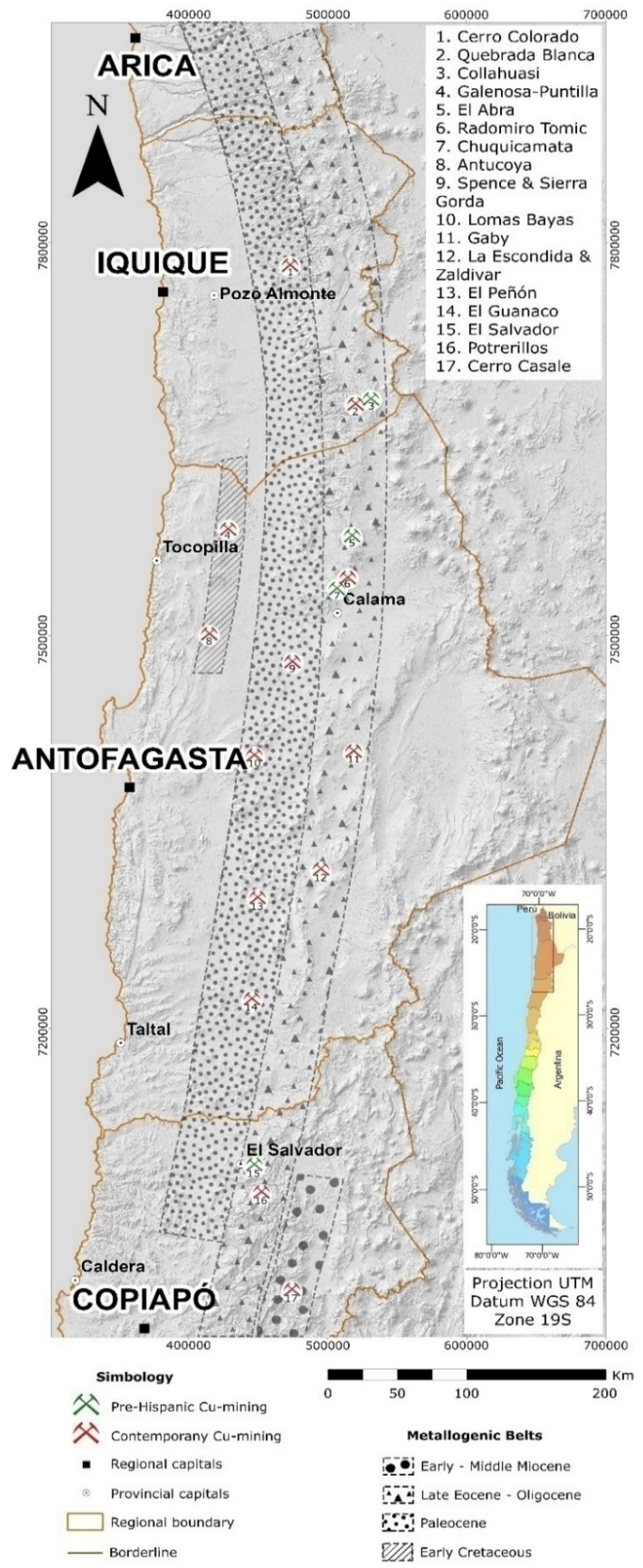
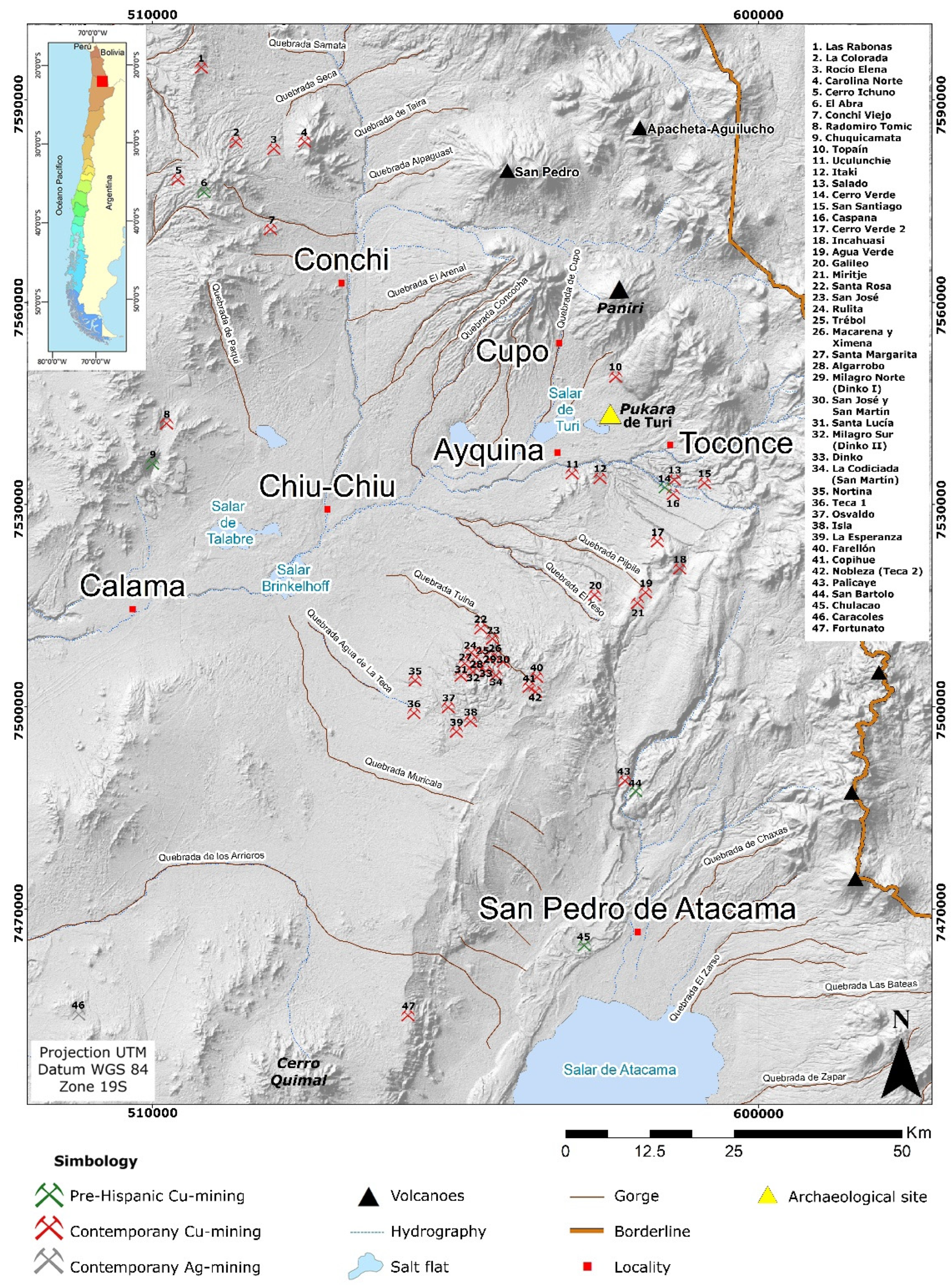
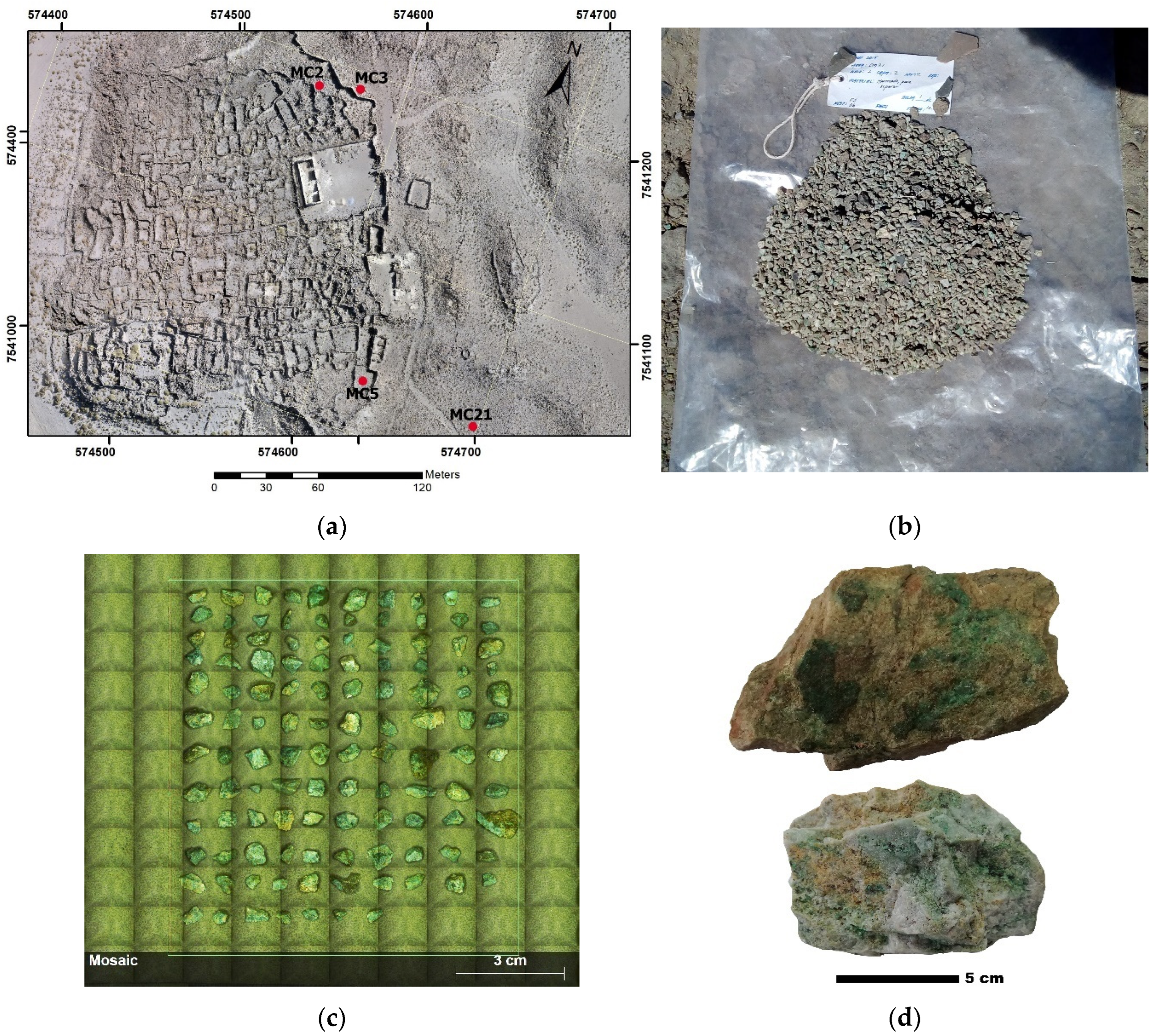
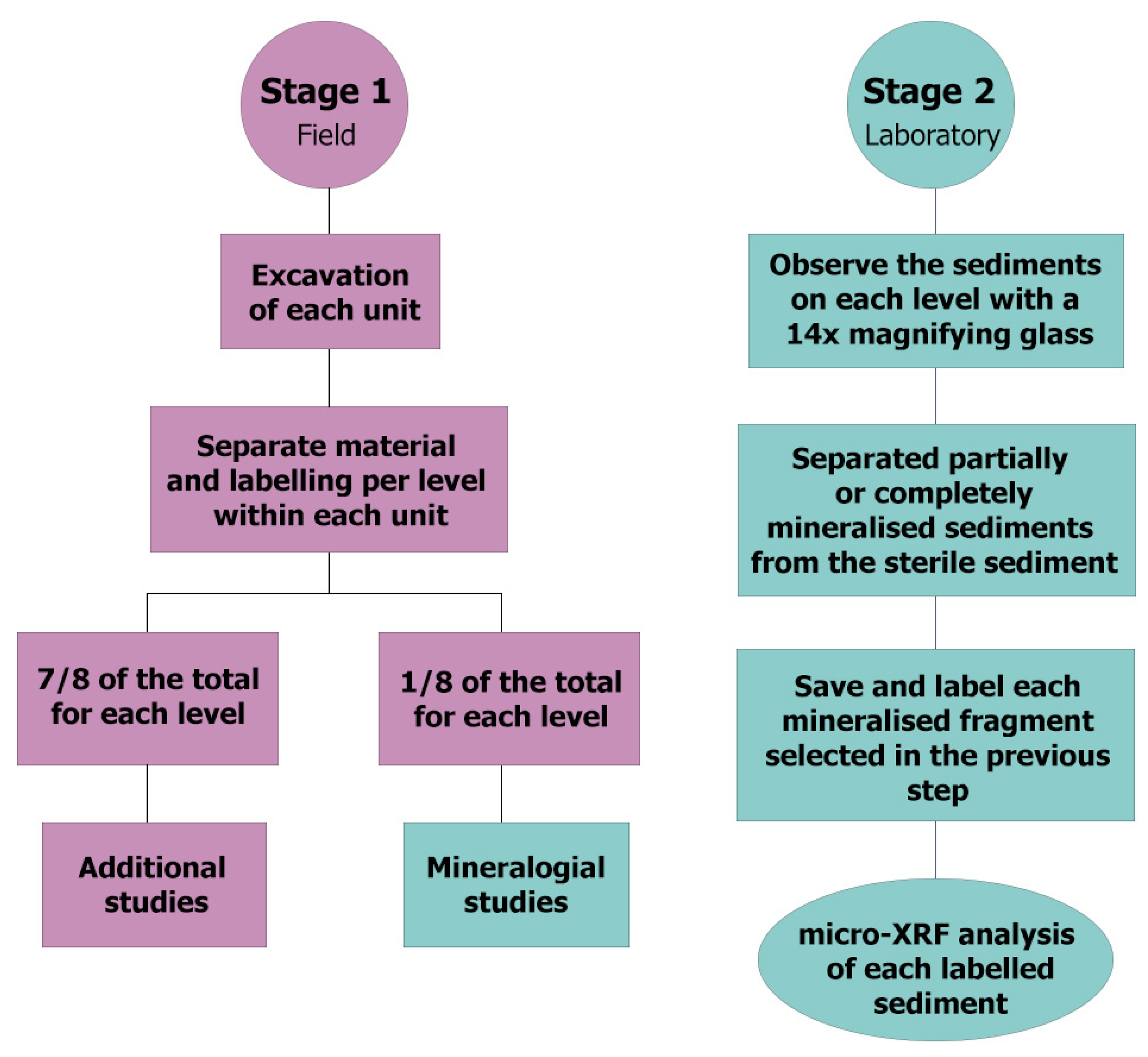
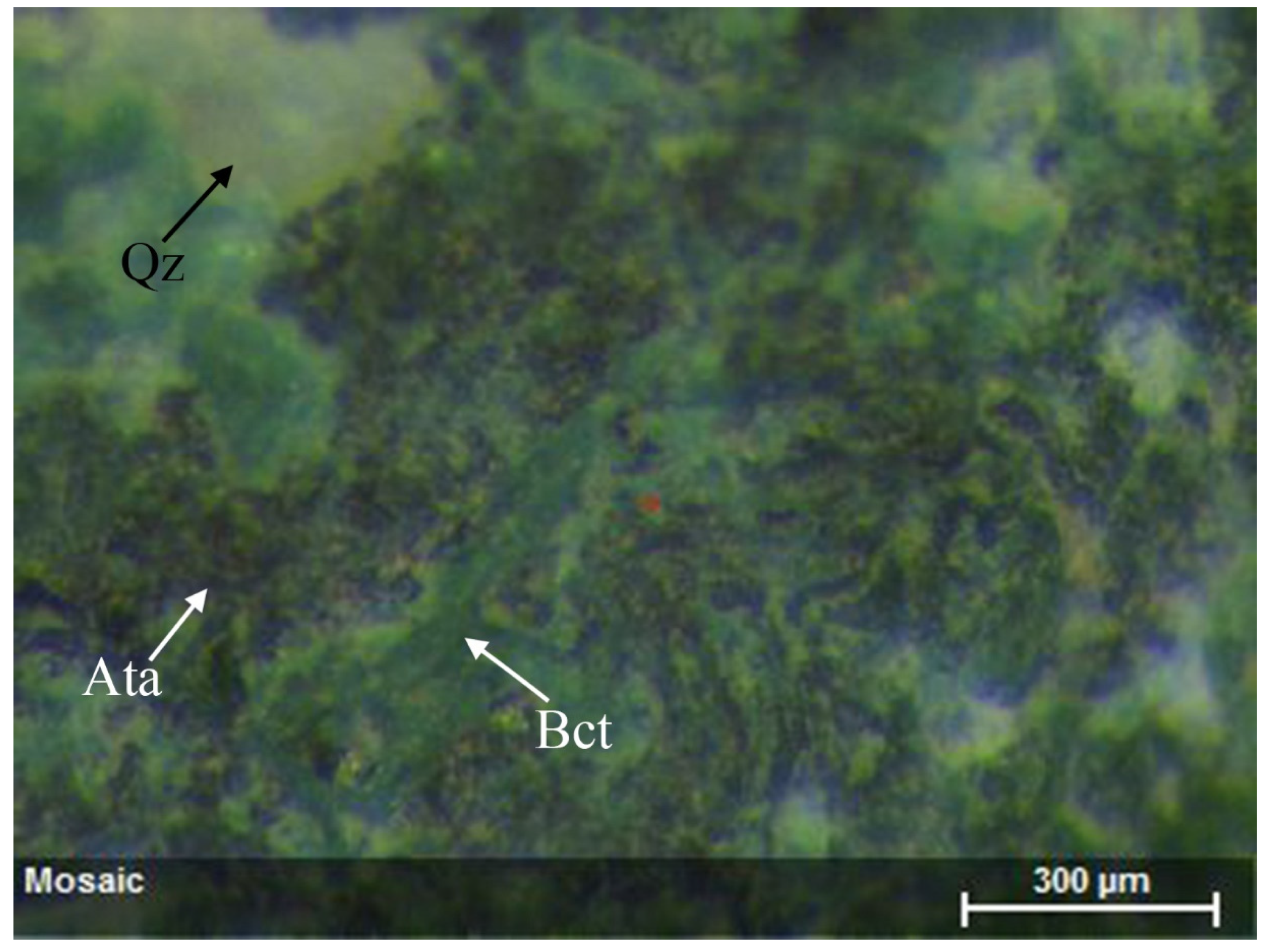
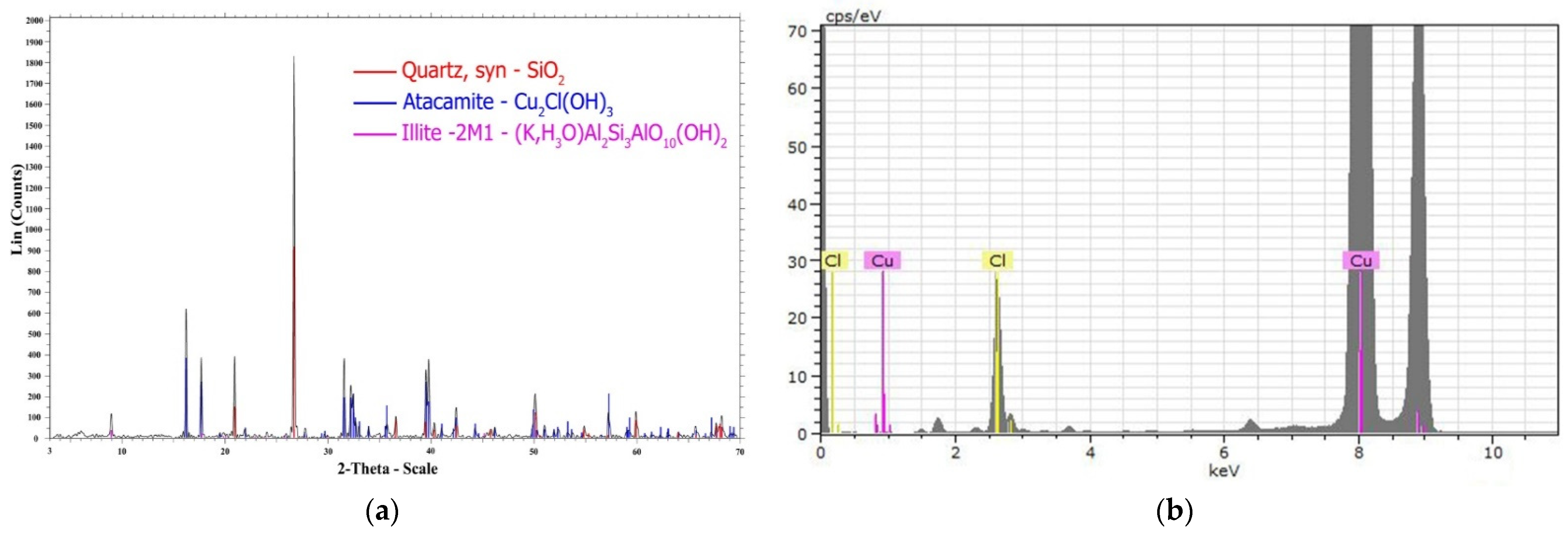
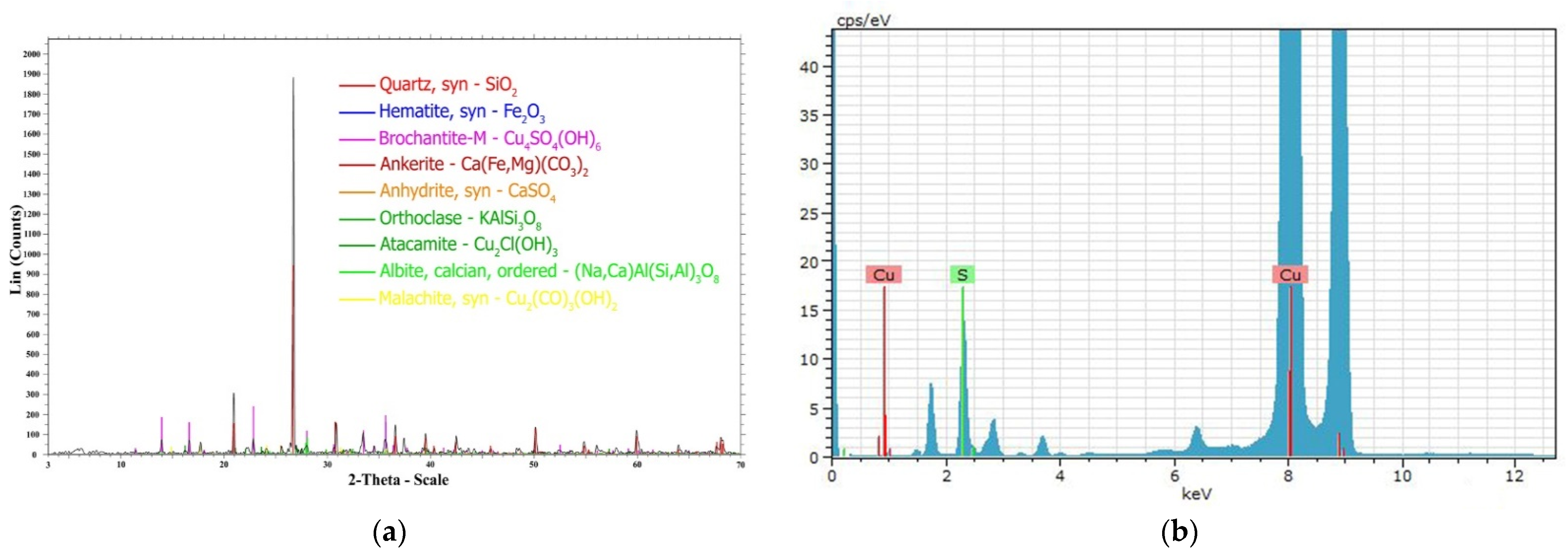
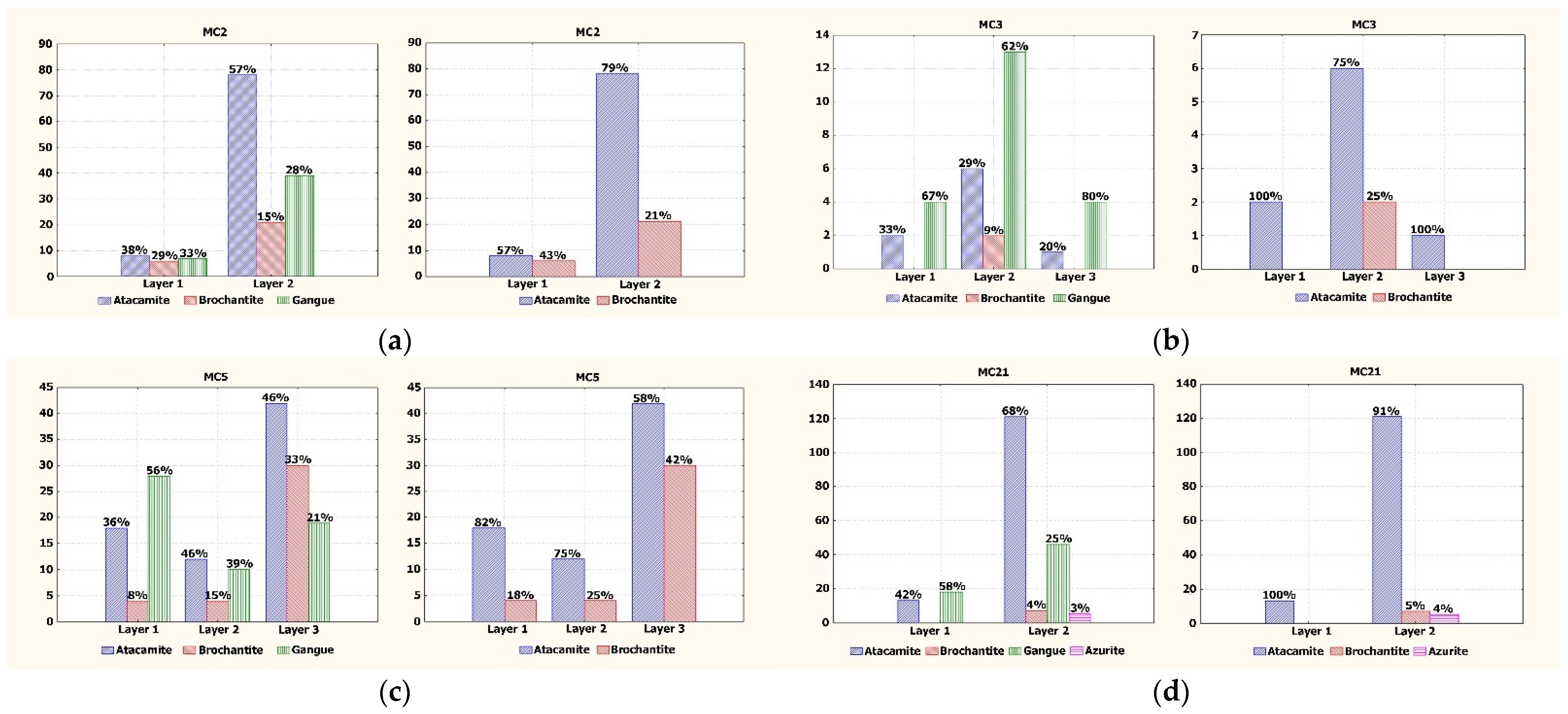
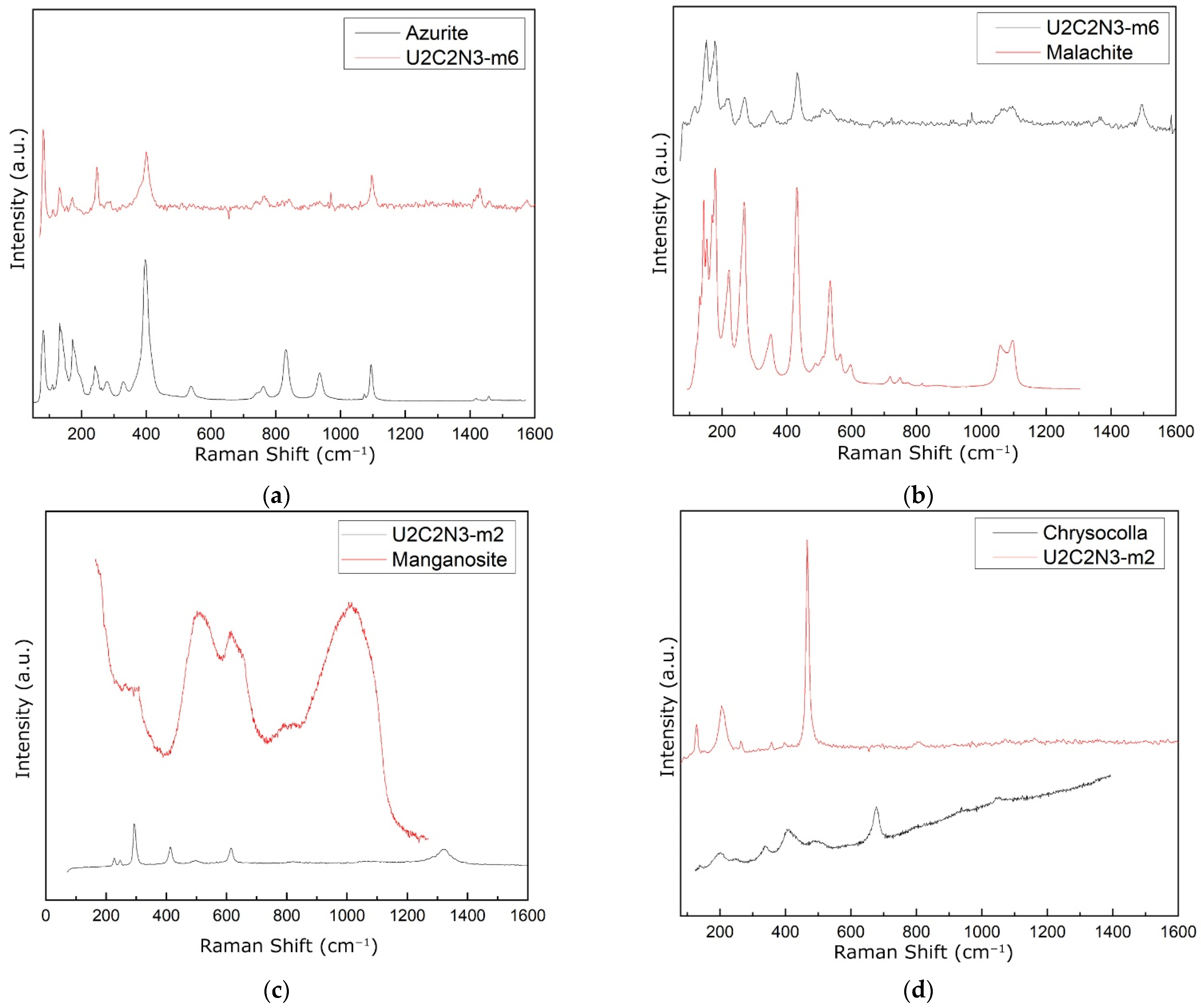
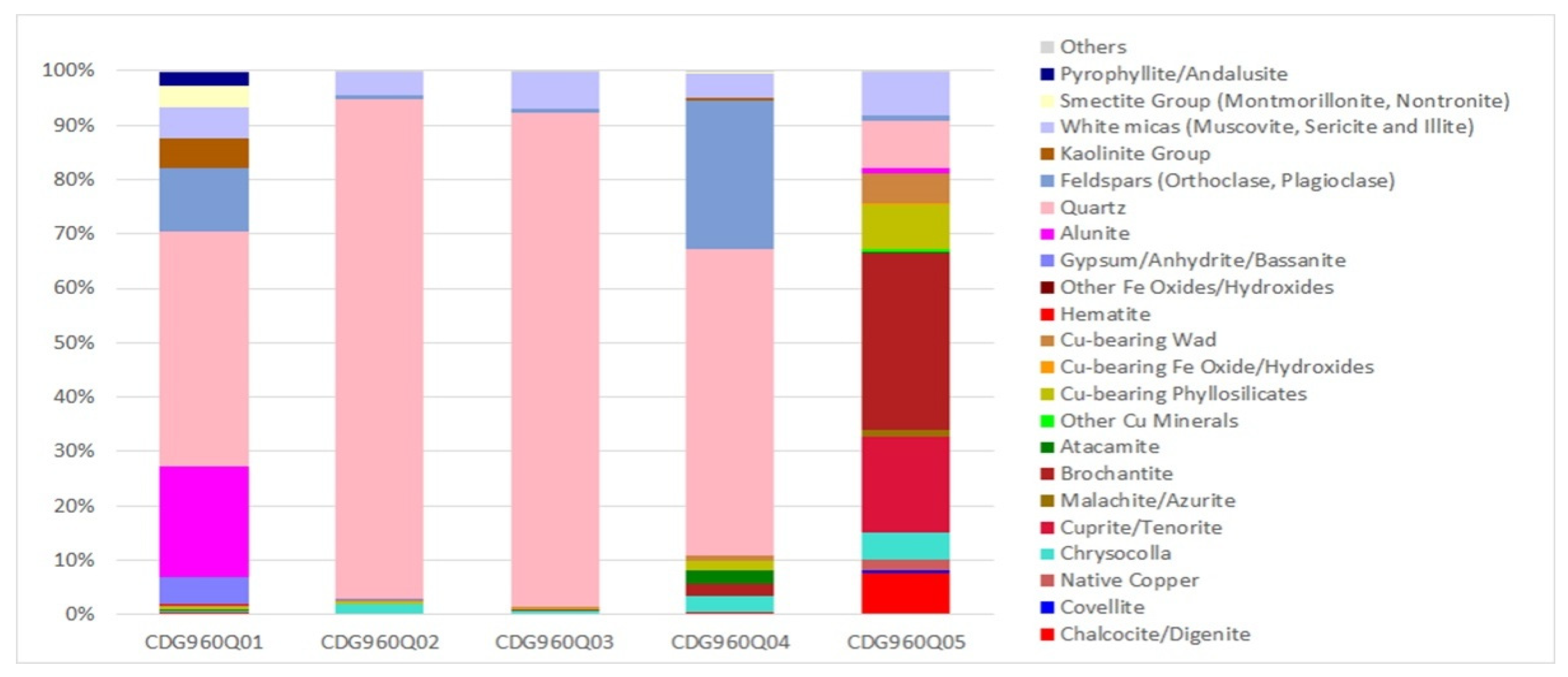
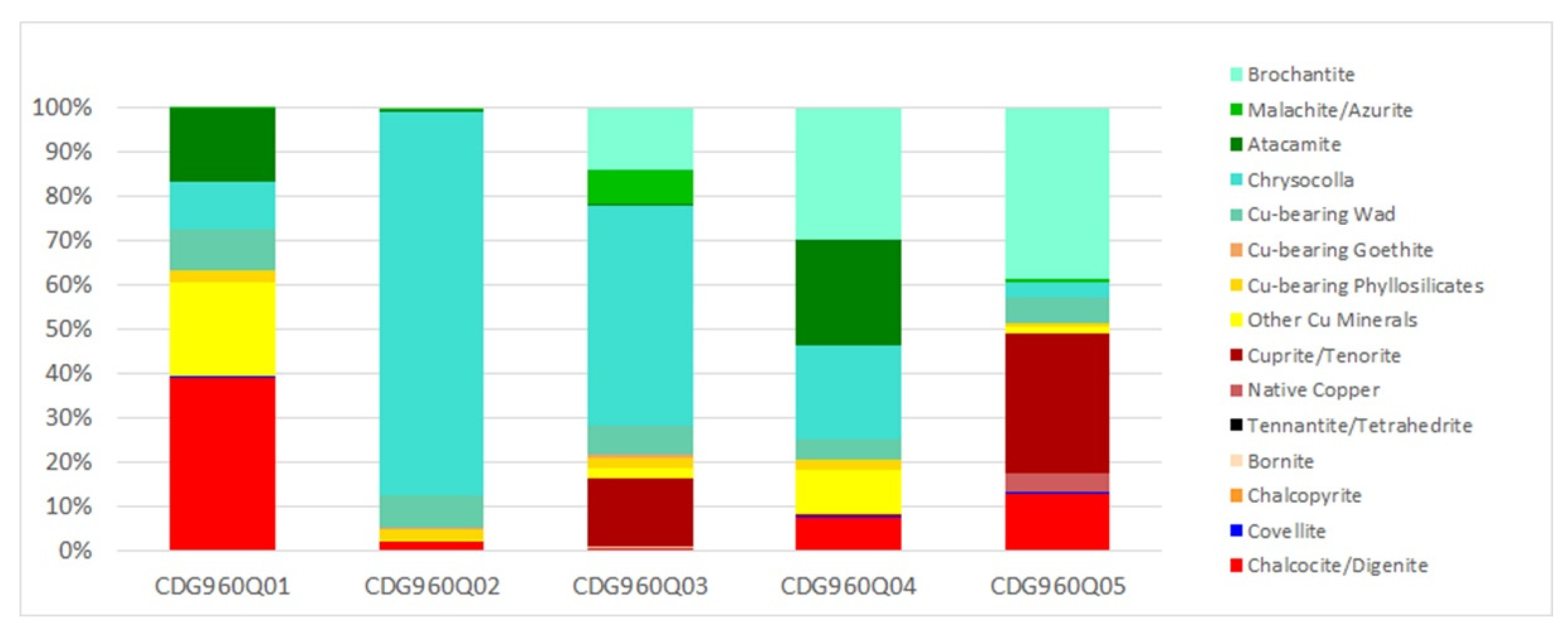
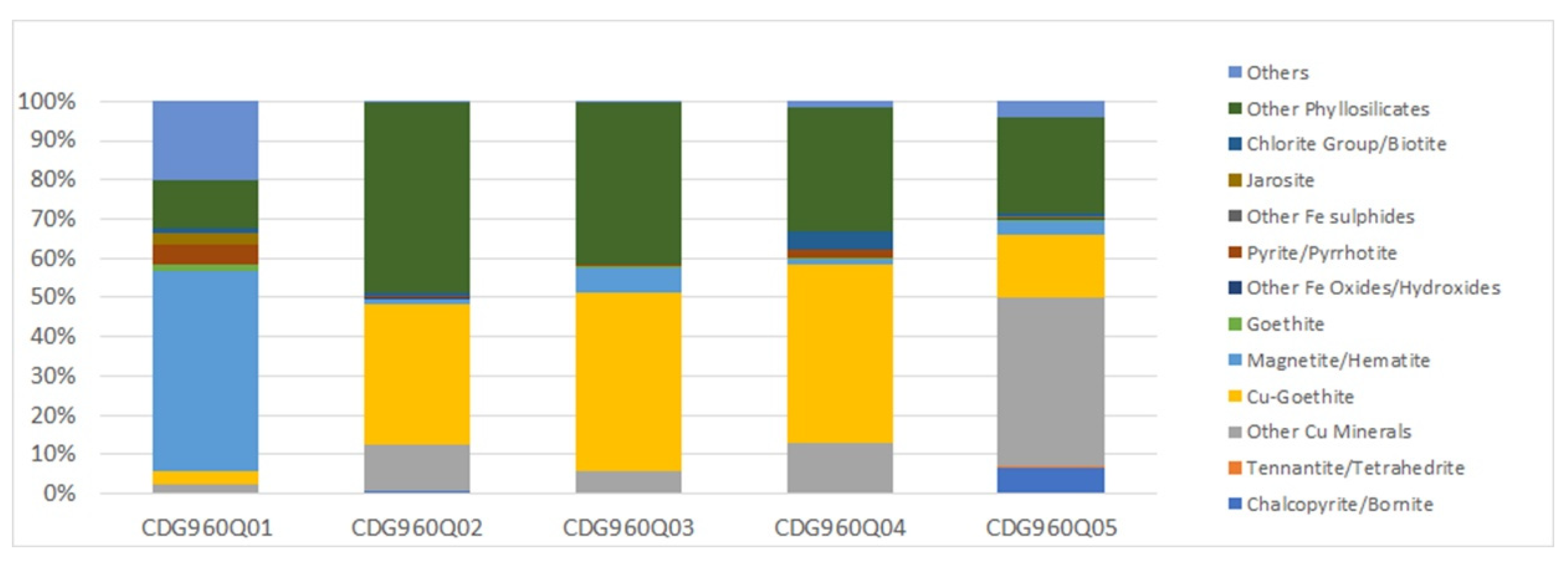
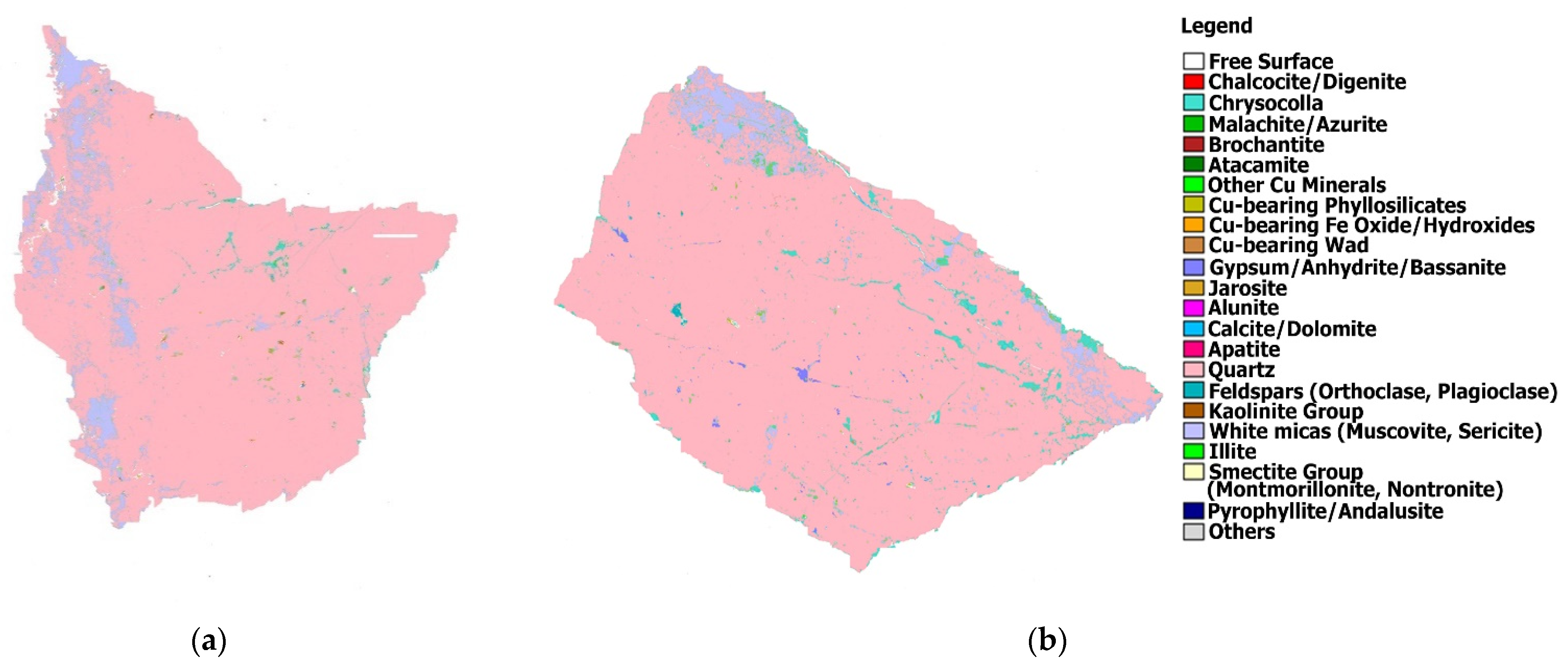
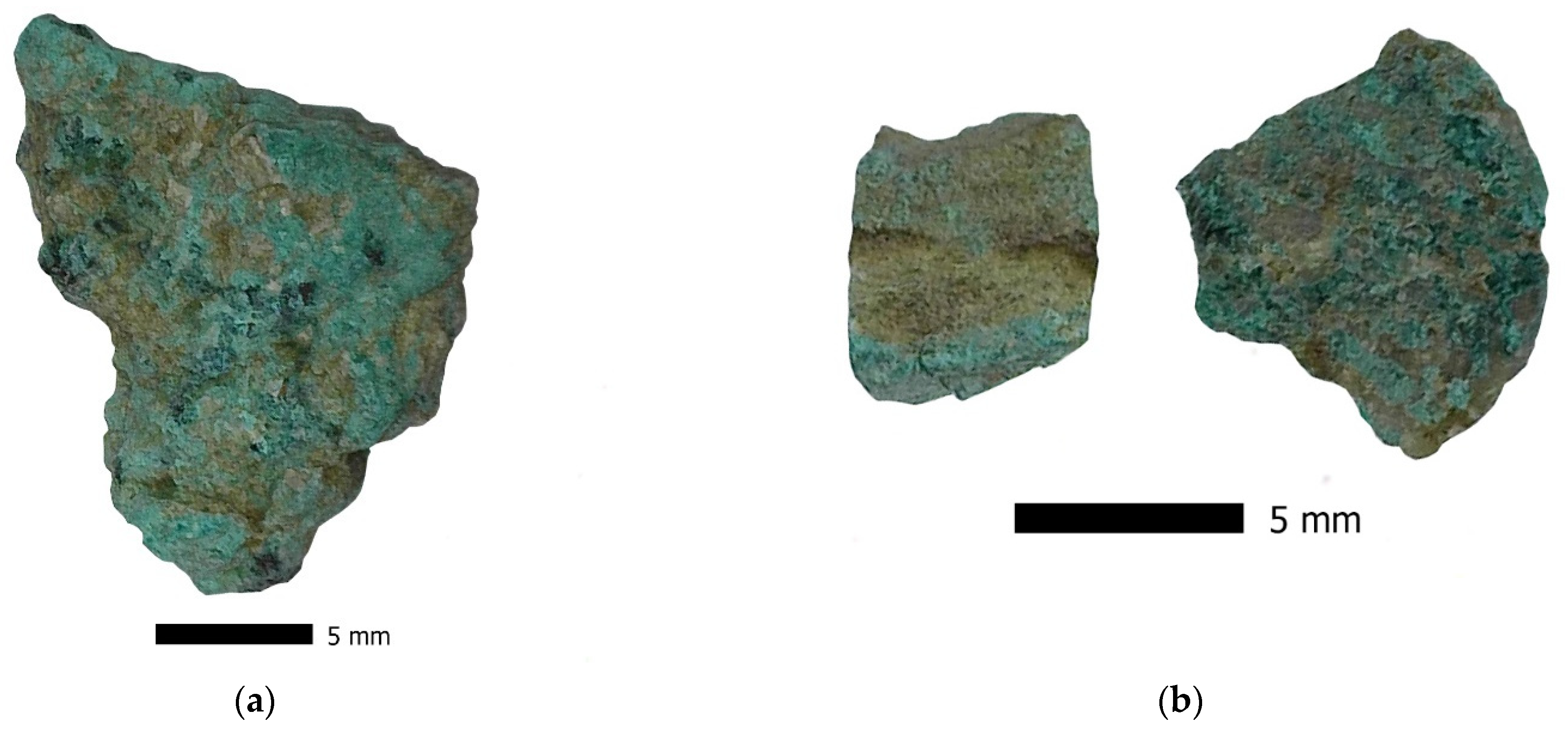
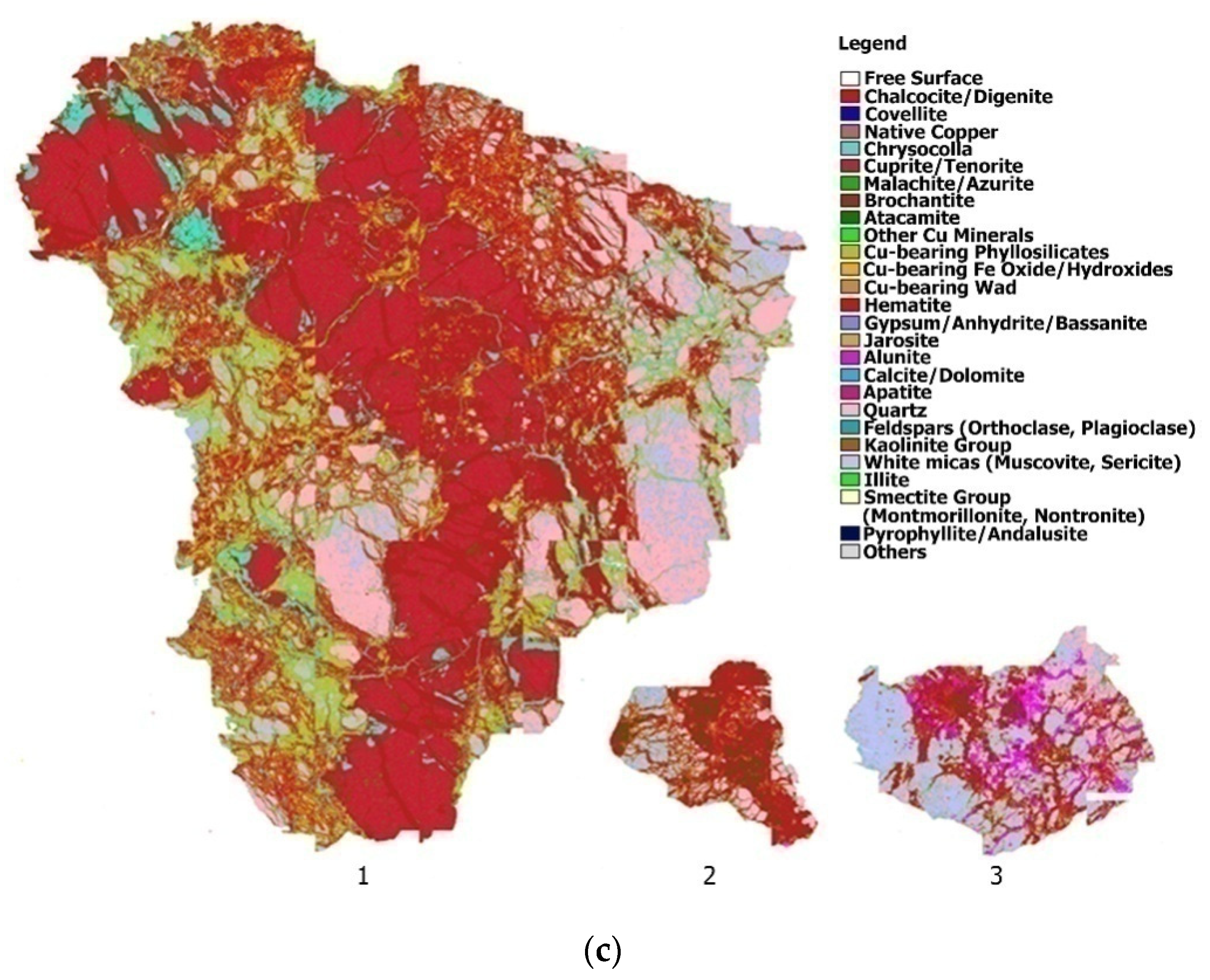
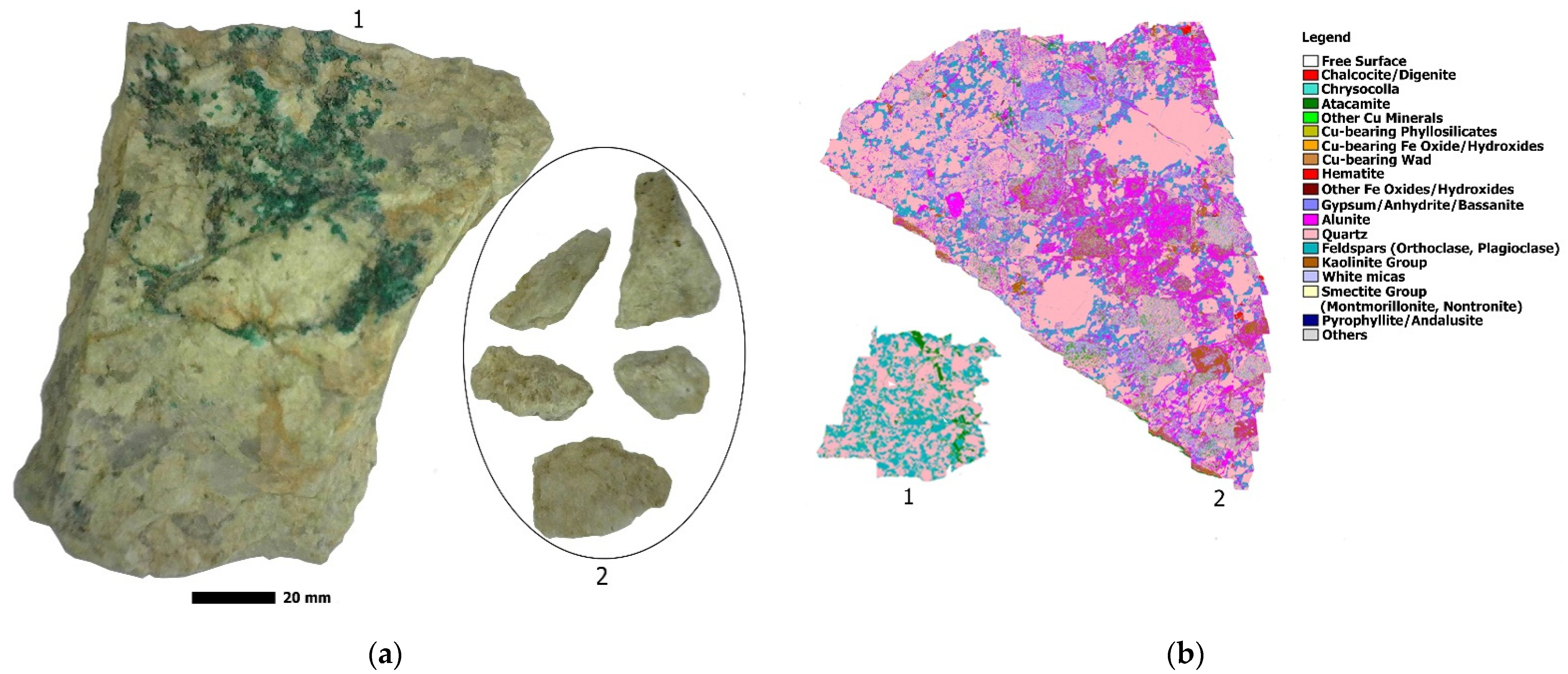
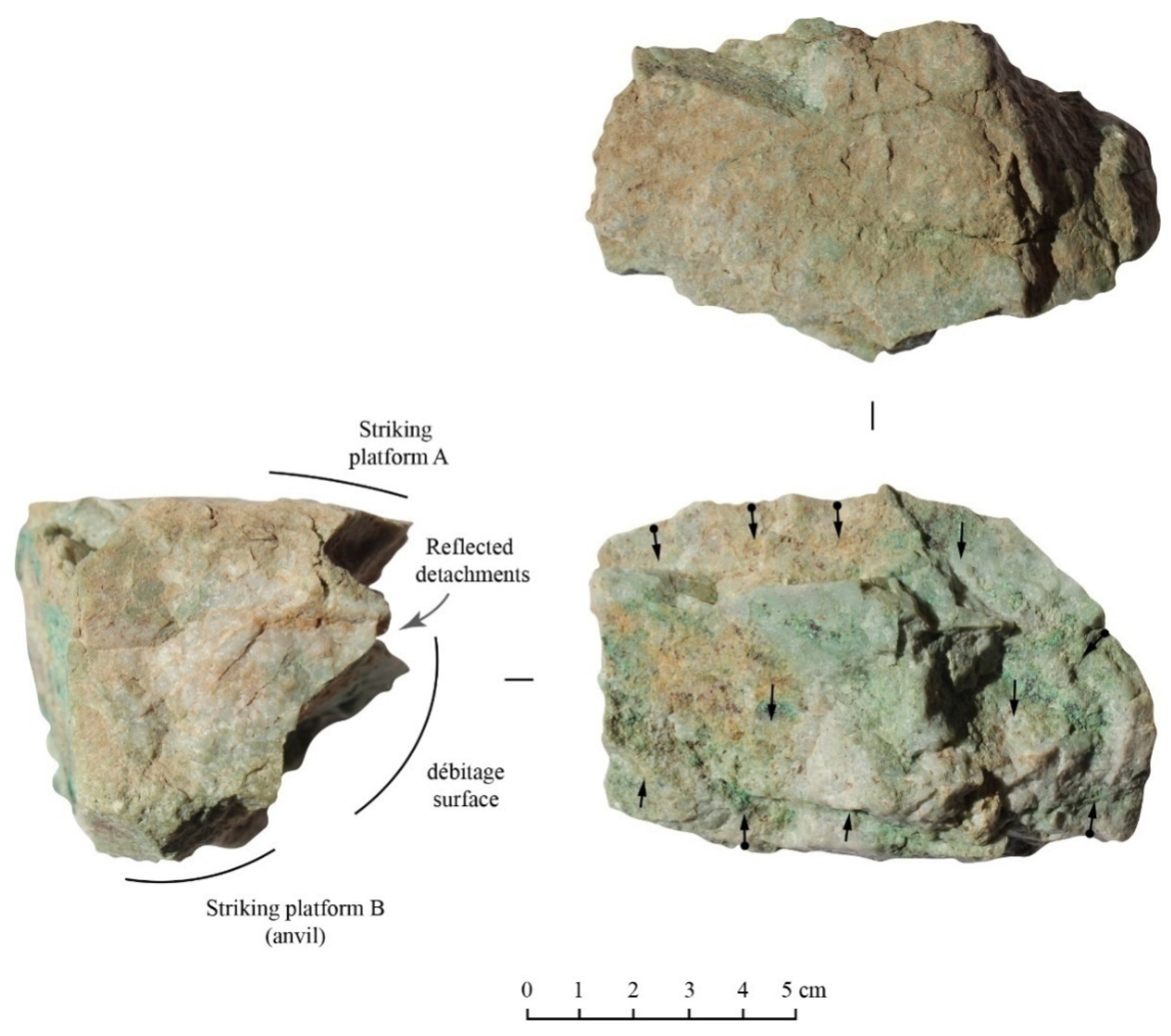
| Unit | Code | Weight (1/8 Total Weight) | Samples Analysed |
|---|---|---|---|
| MC2 | U1C1N1 | 35.29 g | 21 |
| U1C2N1 | 19.31 g | 14 | |
| U1C2N2 | 41.35 g | 36 | |
| U1C2N3 | 56.13 g | 26 | |
| U1C2N4 | 27.64 g | 12 | |
| U1C2N5 | 42.52 g | 50 | |
| MC3 | U1C1N1 | 18.74 g | 6 |
| U1C2N1 | 24.14 g | 21 | |
| U1C3N1 | 6.43 g | 5 | |
| MC5 | U1C1N1 | 107.24 g | 50 |
| U1C2N1 | 47.86 g | 26 | |
| U1C3N1 | 77.65 g | 40 | |
| U1C3N2 | 32.45 g | 25 | |
| U1C3N2-rasgo | 11.28 g | 9 | |
| U1C3N3 | 100.34 g | 17 | |
| MC21 | U2C1N1 | 105.67 g | 31 |
| U2C2N1 | 14.78 g | 48 | |
| U2C2N2 | 114.33 g | 11 | |
| U2C2N3 | 76.08 g | 120 |
| Analytical Parameter | Selection |
|---|---|
| Goniometer | Vertical Bragg–Brentano |
| Radiation | Cu Ka1 (I = 1.5406 Å) |
| Voltage | 40 kv |
| Intensity | 30 mA |
| Detector | Scintillation counter |
| Secondary monochromator | Not applicable |
| Slits | 1 mm/1 mm/0.2 mm |
| Scan range | 3–70° 2θ |
| Step size | 0.020° 2θ |
| Step time | 1.10 s |
| Data base | ICDD (International Centre for Diffraction Data) |
| Quantification program | TOPAS (Total Pattern Analysis Software) |
| Mineral Mass (%) | CDG960Q01 | CDG960Q02 | CDG960Q03 | CDG960Q04 | CDG960Q05 |
|---|---|---|---|---|---|
| Chalcocite/Digenite | 0.34 | 0.02 | 0.00 | 0.43 | 7.67 |
| Covellite | 0.00 | 0.00 | 0.00 | 0.03 | 0.38 |
| Native Copper | 0.00 | 0.00 | 0.00 | 0.00 | 2.00 |
| Chrysocolla | 0.22 | 1.96 | 0.65 | 2.86 | 5.07 |
| Cuprite/Tenorite | 0.00 | 0.00 | 0.08 | 0.00 | 17.52 |
| Malachite/Azurite | 0.00 | 0.01 | 0.06 | 0.01 | 1.24 |
| Brochantite | 0.00 | 0.00 | 0.11 | 2.36 | 32.56 |
| Atacamite | 0.30 | 0.00 | 0.00 | 2.38 | 0.17 |
| Other Cu Minerals | 0.14 | 0.01 | 0.02 | 0.17 | 0.66 |
| Cu-bearing Phyllosilicates | 0.40 | 0.33 | 0.19 | 1.56 | 8.24 |
| Cu-bearing Fe Oxide/Hydroxides | 0.02 | 0.04 | 0.09 | 0.10 | 0.07 |
| Cu-bearing Wad | 0.23 | 0.24 | 0.11 | 0.97 | 5.62 |
| Hematite | 0.22 | 0.00 | 0.00 | 0.00 | 0.01 |
| Other Fe Oxides/Hydroxides | 0.02 | 0.00 | 0.01 | 0.00 | 0.00 |
| Gypsum/Anhydrite/Bassanite | 4.95 | 0.23 | 0.01 | 0.01 | 0.01 |
| Alunite | 20.43 | 0.01 | 0.01 | 0.01 | 0.81 |
| Quartz | 43.14 | 92.05 | 90.96 | 56.42 | 8.86 |
| Feldspars (Orthoclase, Plagioclase) | 11.72 | 0.63 | 0.65 | 27.27 | 0.81 |
| Kaolinite Group | 5.56 | 0.01 | 0.01 | 0.43 | 0.14 |
| White Micas (Muscovite, Sericite and Illite) | 5.57 | 4.23 | 6.71 | 4.62 | 7.83 |
| Smectite Group (Montmorillonite, Nontronite) | 3.91 | 0.01 | 0.02 | 0.10 | 0.07 |
| Pyrophyllite/Andalusite | 2.51 | 0.01 | 0.01 | 0.03 | 0.04 |
| Others | 0.32 | 0.22 | 0.29 | 0.26 | 0.20 |
| Total | 100.00 | 100.00 | 100.00 | 100.00 | 100.00 |
| Mineral Mass (%) | CDG960Q01 | CDG960Q02 | CDG960Q03 | CDG960Q04 | CDG960Q05 |
|---|---|---|---|---|---|
| Chalcocite/Digenite | 0.27 | 0.01 | 0.00 | 0.34 | 6.06 |
| Covellite | 0.00 | 0.00 | 0.00 | 0.02 | 0.26 |
| Chalcopyrite | 0.00 | 0.00 | 0.00 | 0.00 | 0.01 |
| Bornite | 0.00 | 0.00 | 0.00 | 0.00 | 0.00 |
| Tennantite/Tetrahedrite | 0.00 | 0.00 | 0.00 | 0.00 | 0.02 |
| Native Copper | 0.00 | 0.00 | 0.00 | 0.00 | 2.00 |
| Cuprite/Tenorite | 0.00 | 0.00 | 0.07 | 0.00 | 14.97 |
| Other Cu Minerals | 0.14 | 0.00 | 0.01 | 0.45 | 0.68 |
| Cu-bearing Phyllosilicates | 0.02 | 0.02 | 0.01 | 0.10 | 0.47 |
| Cu-bearing Goethite | 0.00 | 0.00 | 0.00 | 0.00 | 0.00 |
| Cu-bearing Wad | 0.06 | 0.06 | 0.03 | 0.21 | 2.67 |
| Chrysocolla | 0.07 | 0.66 | 0.22 | 0.95 | 1.61 |
| Atacamite | 0.11 | 0.00 | 0.00 | 1.07 | 0.10 |
| Malachite/Azurite | 0.00 | 0.00 | 0.03 | 0.01 | 0.36 |
| Brochantite | 0.00 | 0.00 | 0.06 | 1.32 | 18.30 |
| Total | 0.69 | 0.76 | 0.43 | 4.48 | 47.51 |
| Minerals | CDG960Q01 | CDG960Q02 | CDG960Q3 | CDG960Q4 | CDG960Q5 |
|---|---|---|---|---|---|
| Chalcopyrite/Bornite | 0.00 | 0.00 | 0.00 | 0.00 | 0.02 |
| Tennantite/Tetrahedrite | 0.00 | 0.00 | 0.00 | 0.00 | 0.00 |
| Other Cu Minerals | 0.01 | 0.01 | 0.01 | 0.01 | 0.11 |
| Cu-Goethite | 0.01 | 0.02 | 0.05 | 0.05 | 0.04 |
| Magnetite/Hematite | 0.16 | 0.00 | 0.01 | 0.00 | 0.01 |
| Goethite | 0.00 | 0.00 | 0.00 | 0.00 | 0.00 |
| Other Fe Oxides/Hydroxides | 0.00 | 0.00 | 0.00 | 0.00 | 0.00 |
| Pyrite/Pyrrhotite | 0.02 | 0.00 | 0.00 | 0.00 | 0.00 |
| Other Fe Sulphides | 0.00 | 0.00 | 0.00 | 0.00 | 0.00 |
| Jarosite | 0.01 | 0.00 | 0.00 | 0.00 | 0.00 |
| Chloride Group/Biotite | 0.00 | 0.00 | 0.00 | 0.01 | 0.00 |
| Other Phyllosilicates | 0.04 | 0.03 | 0.04 | 0.04 | 0.06 |
| Others | 0.06 | 0.00 | 0.00 | 0.00 | 0.01 |
| Total | 0.31 | 0.06 | 0.11 | 0.12 | 0.25 |
Publisher’s Note: MDPI stays neutral with regard to jurisdictional claims in published maps and institutional affiliations. |
© 2021 by the authors. Licensee MDPI, Basel, Switzerland. This article is an open access article distributed under the terms and conditions of the Creative Commons Attribution (CC BY) license (https://creativecommons.org/licenses/by/4.0/).
Share and Cite
Sapiains, P.; Figueroa, V.; Hayashida, F.; Salazar, D.; Menzies, A.; González, C.; Loyola, R.; Murphy, B.; González, J.; Parcero-Oubiña, C.; et al. Supergene Copper and the Ancient Mining Landscapes of the Atacama Desert: Refining the Protocol for the Study of Archaeological Copper Minerals through the Case Study of Pukara de Turi. Minerals 2021, 11, 1402. https://doi.org/10.3390/min11121402
Sapiains P, Figueroa V, Hayashida F, Salazar D, Menzies A, González C, Loyola R, Murphy B, González J, Parcero-Oubiña C, et al. Supergene Copper and the Ancient Mining Landscapes of the Atacama Desert: Refining the Protocol for the Study of Archaeological Copper Minerals through the Case Study of Pukara de Turi. Minerals. 2021; 11(12):1402. https://doi.org/10.3390/min11121402
Chicago/Turabian StyleSapiains, Pía, Valentina Figueroa, Frances Hayashida, Diego Salazar, Andrew Menzies, Cristián González, Rodrigo Loyola, Beau Murphy, Juan González, César Parcero-Oubiña, and et al. 2021. "Supergene Copper and the Ancient Mining Landscapes of the Atacama Desert: Refining the Protocol for the Study of Archaeological Copper Minerals through the Case Study of Pukara de Turi" Minerals 11, no. 12: 1402. https://doi.org/10.3390/min11121402
APA StyleSapiains, P., Figueroa, V., Hayashida, F., Salazar, D., Menzies, A., González, C., Loyola, R., Murphy, B., González, J., Parcero-Oubiña, C., & Troncoso, A. (2021). Supergene Copper and the Ancient Mining Landscapes of the Atacama Desert: Refining the Protocol for the Study of Archaeological Copper Minerals through the Case Study of Pukara de Turi. Minerals, 11(12), 1402. https://doi.org/10.3390/min11121402







